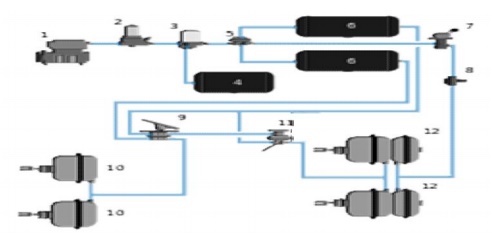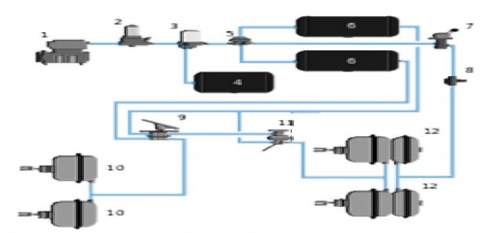Chapter: Mechanical : Automobile Engineering : Steering, Brakesa and Suspension Systems
Pneumatic braking system

Pneumatic braking system
An air brake or, more formally, a compressed air brake system,
is a type of friction brake for vehicles in which compressed air pressing on a
piston is used to apply the pressure to the brake pad needed to stop the
vehicle.
Air brakes are used in large heavy vehicles, particularly
those having multiple trailers which must be linked into the brake system, such
as trucks, buses, trailers, and semi-trailers in addition to their use in
railroad trains.
George Westinghouse first developed air brakes for use in
railway service. He patented a safer air brake on March 5, 1872. Westinghouse
made numerous alterations to improve his air pressured brake invention, which
led to various forms of the automatic brake. In the early 20th century, after
its advantages were proven in railway use, it was adopted by manufacturers of
trucks and heavy road vehicles.
Construction of Braking system;
Air brake systems are typically used on heavy trucks and
buses. The system consists of service brakes, parking brakes, a control pedal,
and an air storage tank. For the parking brake, there is a disc or drum brake
arrangement which is designed to be held in the 'applied' position by spring
pressure.
Air pressure must be produced to release these "spring
brake" parking brakes. For the service brakes (the ones used while driving
for slowing or stopping) to be applied, the brake pedal is pushed, routing the
air under pressure (approx 100–120 psi or 690–830 kPa)
to the brake chamber, causing the brake to be engaged. Most types of truck air
brakes are drum brakes, though there is an increasing trend towards the use of
disc brakes in this application. The air compressor draws filtered air from the
atmosphere and forces it into high-pressure reservoirs at around 120 psi (830
kPa).
Most heavy vehicles have a gauge within the driver's view,
indicating the availability of air pressure for safe vehicle operation, often
including warning tones or lights. Setting of the parking/emergency brake
releases the pressurized air in the lines between the compressed air storage
tank and the brakes, thus allowing the spring actuated parking brake to engage.
A sudden loss of air pressure would result in full spring brake pressure
immediately.
A compressed air brake system is divided into a supply system
and a control system. The supply system compresses, stores and supplies
high-pressure air to the control system as well as to additional air operated
auxiliary truck systems (gearbox shift control, clutch pedal air assistance
servo, etc.).

Highly
simplified air brake diagram on a commercial road vehicle (does not show all
air
reservoirs and
all applicable air
valves). The air compressor is
driven by the engine either
by crankshaft pulley via a beltor
directly from the engine timing gears. It is lubricated and cooled by
the engine lubrication and cooling systems.
Compressed air is first routed through a cooling coil and into
an air dryer which removes moisture and oil impurities and also may include a
pressure regulator, safety valve and smaller purge reservoir. As an alternative
to the air dryer, the supply system can be equipped with an anti-freeze device
and oil separator. The compressed air is then stored in a reservoir (also
called a wet tank) from which it is then distributed via a four way protection
valve into the front and rear brake circuit air reservoir, a parking brake
reservoir and an auxiliary air supply distribution point. The system also
includes various check, pressure limiting, drain and safety valves.Air brake
systems may include a wig wag device which deploys to warn the driver if the
system air pressure drops too low.
Control system
The control system is further divided into two service brake
circuits: the parking brake circuit and the trailer brake circuit. This dual
brake circuit is further split into front and rear wheel circuits which receive
compressed air from their individual reservoirs for added safety in case of an
air leak. The service brakes are applied by means of a brake pedal air valve
which regulates both circuits.
The parking brake is the air operated spring brake type where
its applied by spring force in the spring brake cylinder and released by
compressed air via hand control valve. The trailer brake consists of a direct
two line system: the supply line (marked red) and the separate control or
service line (marked blue). The supply line receives air from the prime mover
park brake air tank via a park brake relay valve and the control line is
regulated via the trailer brake relay valve. The operating signals for the
relay are provided by the prime mover brake pedal air valve, trailer service
brake hand control (subject to a country's relevant heavy vehicle legislation)
and the prime mover park brake hand control.
Advantages of Air Brakes;
Air brakes are used as an alternative to hydraulic brakes
which are used on lighter vehicles such as automobiles. Hydraulic brakes use a
liquid (hydraulic fluid) to transfer pressure from the brake pedal to the brake
shoe to stop the vehicle. Air brakes have several advantages for large
multitrailer vehicles:
·
The supply of air is unlimited, so the brake
system can never run out of its operating fluid, as hydraulic brakes can. Minor
leaks do not result in brake failures.
·
Air line couplings are easier to attach and detach
than hydraulic lines; there is no danger of letting air into hydraulic fluid.
So air brake circuits of trailers can be attached and removed easily by
operators with little training.
·
Air not only serves as a fluid for transmission of
force, but also stores potential energy. So it can serve to control the force
applied. Air brake systems include an air tank that stores sufficient energy to
stop the vehicle if the compressor fails.
Air brakes are effective even with considerable leakage, so an
air brake system can be designed with sufficient "fail-safe" capacity
to stop the vehicle safely even when leaking.
Related Topics